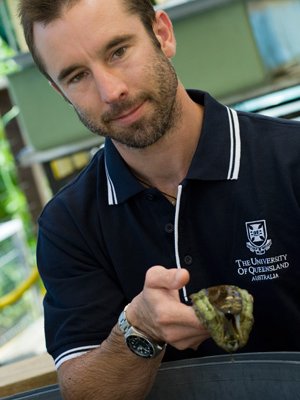
Designer abalone could be an option in the foreseeable future, thanks to a project associated with UQ’s Heron Island Research Station.
Sol York, a PhD student with UQ’s School of Biological Sciences, is uncovering how to breed fast-growing abalone, a study which has attracted significant interest from the aquaculture industry.
“We’re looking at a variety of candidate genes to investigate the differences between the fast and the slow growers,” he said.
“We can actually compare gene activity levels between fast growing abalone and abalone that are growing more slowly.
“If particular genes are being really highly expressed in fast growing ones, that suggests to us that those genes are producing products that might be generating this rapid growth.”
Mr York said while some abalone were genetically predisposed to grow more quickly, the reproductive process was also a contributing factor.
“There seems to be this trade off – if you’re busy breeding or producing a lot of eggs to reproduce, your growth tends to slow down, whereas when you’re not breeding, you can put your resources into growth,” he said.
“I’m using that comparison between breeding and non breeding animals to see what hormones might be coming and going at those different times.”
Using protein analysis methods, Mr York hopes to find out which hormones are present in the blood of abalone at different times during the breeding cycle.
Once the growth-causing genes have been identified, he will have two options, both of which are likely to interest the aquaculture industry.
“I guess the hope is that once you’ve identified the gene that’s producing these growth-related hormones you might be able to manipulate it so that you can make that gene stay turned on for a longer period of time,” he said.
“Or opposite to that you might be able to inhibit the genes that actually trigger reproduction in the abalone.
“If you stop it reproducing then, rather than putting resources into reproduction, it will just continue to put energy and resources into growth.
“That’s highly achievable once we pin down those genes and we seem like we’re getting pretty close.
“It’s easy to imagine why aquaculture would appreciate that.
“People pay a fortune for this meat and if they can have the abalone in their facility for a shorter time and still get the same amount of meat and same amount of dollar, then they can just keep turning over their profit.”
Mr York is supervised by Professor Bernie Degnan, Dr Sandie Degnan, Dr Scott Cummins, Dr Elizabeth O'Brien, and Associate Professor Andrew Barnes, and hopes to complete his PhD within two years.
He is funded by an Australian Postgraduate Award Industry scholarship with support from Coral Coast Mariculture and also the Department of Primary Industries and Fisheries.
Media: Mr York (07 3365 1037, s4136480@student.uq.edu.au) or Penny Robinson at UQ Communications (07 3365 9723, penny.robinson@uq.edu.au)


